Cheers! ‘Carbon markets in US, Europe & Asia are collapsing, with prices so low they’ve become virtually valueless’
LONDON, July 8 — Carbon markets, the free-enterprise solution to saving the world from global warming, are now in danger themselves.
The idea was simple enough: Set a cap on carbon emissions, issue enough permits to allow power plants, refineries and the like to stay within those limits and then shrink the cap over time to achieve reductions. The companies whose emissions fall fastest can sell their permits for a profit to slower responders — call it a reward for good behaviour.
The reality, though, is more complex. Undercut by a lack of political will on the size of caps and overtaken by costly new environmental mandates, carbon markets in the US, Europe and Asia are collapsing, with prices so low they’ve become virtually valueless. The credits auctioned in the US Northeast in June, for instance, sold for just US$4.53 (RM18.27) a short tonne, a 40 per cent drop from December.
“Climate policy has been muddled and messy,” said Michael Grubb, a professor at University College London’s Institute for Sustainable Resources who has advised the UK energy regulator. “Governments have set inadequate targets due to lobbying pressures and because they didn’t think carefully enough about overlapping efforts. That has destroyed investor confidence that carbon prices will rise.”
The idea of a carbon market originated 20 years ago with Richard Sandor, an economist who also pioneered interest-rate futures and derivatives at the Chicago Board of Trade. Today, there are 38 countries, cities, states and provinces using pricing systems in an attempt to put a lid on greenhouse gases, according to the World Bank.
The problem is that the permits are selling at a slower and slower rate. The surplus of allowances is becoming so large in systems run by Europe, California and Quebec — which together account for more than 90 per cent of global trading — that by 2022 it could cover the emissions spewing from every car on Earth for a full year, according to estimates by the London environmental group Sandbag Climate Campaign CIC and Bloomberg New Energy Finance.
In California’s market, all 23 million allowances sold in an auction in 2014. In May, 7.3 million permits found buyers, only 11 per cent of what was put up for sale.
– See more at: http://www.themalaymailonline.com/money/article/tough-task-to-prevent-global-warming-when-carbon-is-this-cheap#sthash.EwchrFQQ.dpuf…
June 2016 Update: ‘The Pause still refuses to go away’ – 18 years 8 months – No warming since Nov. 1997
Via: https://kenskingdom.wordpress.com/2016/07/08/the-pause-update-june-2016/
The Pause Update: June 2016
The complete UAH v6.0 data for June were released yesterday. I present all the graphs for various regions, and as well summaries for easier comparison. The Pause still refuses to go away, despite all expectations.
These graphs show the furthest back one can go to show a zero or negative trend (less than 0.1 +/-0.1C per 100 years) in lower tropospheric temperatures. I calculate 12 month running means to remove the small possibility of seasonal autocorrelation in the monthly anomalies. Note: The satellite record commences in December 1978- now 37 years and 7 months long- 451 months. 12 month running means commence in November 1979. The y-axes in the graphs below are at December 1978, so the vertical gridlines denote Decembers. The final plotted points are June 2016.
[CLICK ON IMAGES TO ENLARGE]
Globe:
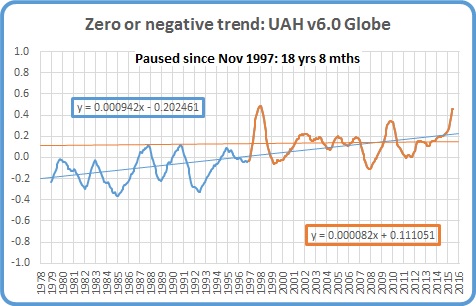
The 12 month mean to June 2016 remains at +0.46C and should stay at about this value for the next two months. If so, The Pause, (now 1 month shorter), will continue to be an embarrassing reality! However, it may end soon after with a small positive trend.
And, for the special benefit of those who think that I am deliberately fudging data by using 12 month running means, here is the plot of monthly anomalies, which shows that The Pause is over by my rather strict criterion:
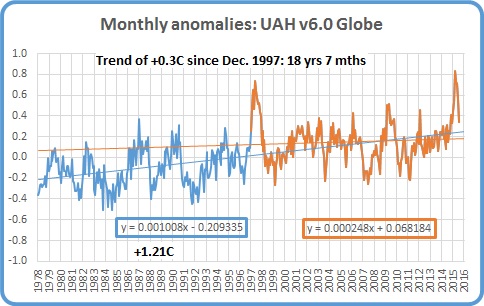
+0.3C/100 years since December 1997- not exactly alarming. The Pause will return sooner with monthly anomalies than 12 month means of course.
Northern Hemisphere:
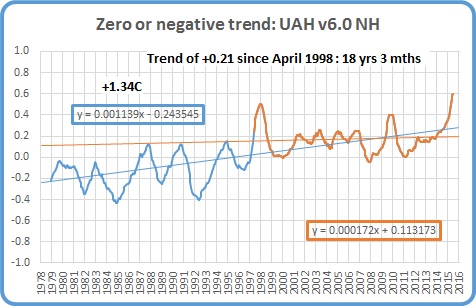
The Northern Hemisphere Pause has ended as expected. Note the not very alarming warming of 0.21 +/- 0.1C per 100 years for half the record compared with 1.37C for the whole period.
Southern Hemisphere:
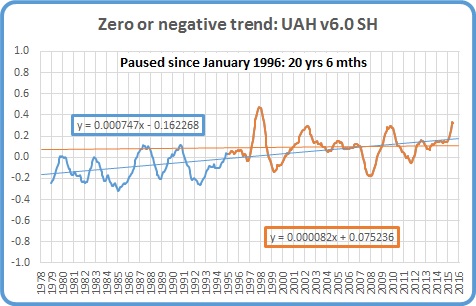
The Pause has shortened by 2 months. For well over half the record the Southern Hemisphere has zero trend.
Tropics:
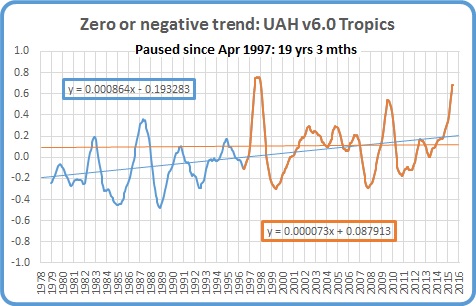
The Pause has shortened by another 3 months with the El Nino influence, but is still over half the record.
Tropical Oceans:
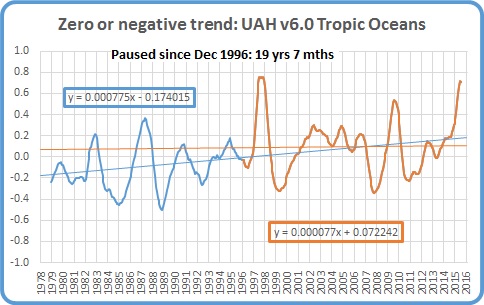
The Pause has shortened by another 2 years- the El Nino now having a strong effect on the 12 month means.
Northern Extra Tropics:
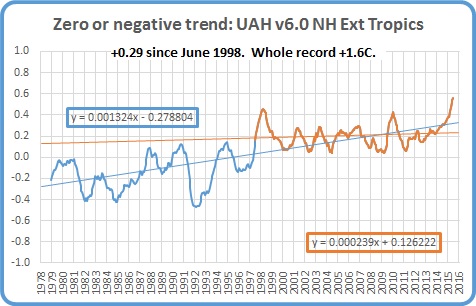
The Pause by this criterion has ended in this region, however note that the slope since 1998 is +0.29 +/- 0.1C per 100 years compared with +1.59C for the whole period. That’s still embarassingly slow warming.
Southern Extra Tropics:
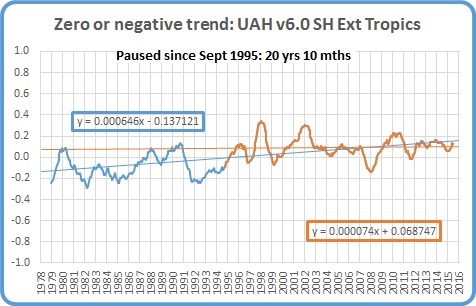
The Pause has lengthened by another month.
Northern
‘Global Warming’ Pause Continues: ‘It looks as if there will be no statistically significant difference between 2016’s temperatures & 1998’s’
RSS Updated For June – Temperature Decline Continues
By Paul Homewood
RSS have also now published their global temperature anomalies for June, so we can update the comparison with 1998 for them and UAH:
http://vortex.nsstc.uah.edu/data/msu/v6.0beta/tlt/uahncdc_lt_6.0beta5
RSS anomalies have now declined by a full half degree since their peak in February.
Both datasets have now been tracking below 1998 levels for the last three months. In 1998, temperatures picked up in the NH summer, so it may be that we see temperature anomalies continue to track lower for the next few months.
Either way, it looks as if there will be no statistically significant difference between this year’s temperatures and 1998’s.
Where Clinton, Trump Stand on Energy, Climate Change
Donald Trump:
- Fracking: Trump has been enthusiastic about this controversial gas extraction process, stating via Twitter as far back as 2012 that “fracking will lead to American energy independence.” His public comments since then have been less succinct, but supportive. In his one major energy policy speech in North Dakota in late May, Trump said he would “revoke policies that impose unwarranted restrictions on new drilling technologies,” an indirect way of saying he wouldn’t regulate methane emissions from fracking rigs, which the Obama administration is currently attempting to do.
- Renewables: Trump doesn’t have the same visceral dislike for subsidies that more ideologically pure Republicans have concerning renewable power, so analysts believe he will not push to have them eliminated. He was also a supporter of ethanol subsidies while campaigning in Iowa.
- EPA/Regulation: Trump has both the temperament and the motivation to attack environmental regulation and the Environmental Protection Agency on all fronts. During his North Dakota speech he promised to rescind by executive order many of the Obama administration’s most ambitious environmental goals, including the EPA’s landmark Climate Action Plan that would close many of the country’s older coal plants.
- Climate Change: Trump’s comment in North Dakota that he would “cancel the Paris Climate Agreement” is a clear rejection of both accepted climate science and attempts to reach global consensus over the past decade concerning greenhouse gas emissions. There probably isn’t a clearer policy difference between the two camps than on climate change, especially given the possible long-term consequences.
- Nuclear: Trump has said very little concerning nuclear power in recent years, although back in 2011, just after the Fukushima disaster, he told Fox News that “nuclear is a way we get what we have to get, which is energy. “ It’s likely his opinion hasn’t changed.
Hillary Clinton
Clinton has had to work much harder politically than Trump in terms of her policy formation, and has moved some of her energy and environmental views to the left, thanks largely to the candidacy of Vermont Sen. Bernie Sanders, who argued aggressively against all fracking and nuclear power production in the United States.
- Fracking: Clinton’s position on this issue has been a little tough to discern. Unlike Trump, who has never run for political office, Clinton has taken a position on every single environmental issue during her nearly quarter-century of public life. As secretary of state, she promoted fracking technology overseas,
Analysis debunks ‘Hottest’ year and CO2 claims – ‘Torturing the Data and the Facts’
http://realitybasedpolicy.com/torturing-the-data-and-the-facts
The statement that CO2 levels and temperatures “track together in the geologic record” is not even grossly right; it is precisely wrong. A report by the CO2 Coalition, Carbon Dioxide Benefits the World: See for Yourself, contains a figure, CO2 Levels on Earth, that shows CO2 levels 600 million years in the past. The following figure clearly shows that over the course of geologic history, CO2 have been declining, while temperatures have increased and decreased.…
Michael Mann Can See Climate Change From His Window!
Mickey Mann Can See Climate Change From His Window!
By Paul Homewood http://www.investors.com/politics/commentary/global-warming-alarmist-reveals-the-anti-science-con/ From Investor’s Daily: Michael Mann, who has staked his reputation on being right about climate change, has apparently abandoned the science that he said he’s kept his “head buried in” for “much” of his career. Mann, a climate scientist chosen to help the Democratic Party draft its election-year platform, has concluded that “these tools that we’ve spent years developing increasingly are unnecessary.” So if the global warming alarmists should no longer use these tools — the climate prediction computer models — to badger the rest of us, then what should they use? Well, just tell some tales, of course. “We can see climate change, the impacts of climate change, now, playing out in real time, on our television screens, in the 24-hour news cycle,” Mann told Democrats at a platform draft hearing last month. “The signal of climate change is no longer subtle, it is obvious.” Maybe Mann, from his ivory tower at Penn State University, is seeing something we’re not. Whatever it is, there’s no way he can, with any degree of certainty, say it’s caused by humans. As we’ve said before, there are simply too many variables to declare without reservation that man’s carbon-dioxide emissions are causing the planet to overheat. Our climate is too complex for an explanation as simplistic as that. Get instant access to exclusive stock lists and powerful tools on Investors.com. Try us free for 4 weeks. But Mann is right about abandoning the models that he’s used to try “to tease out” — isn’t this a second admission that a con is going down? — “the signal of human-caused climate change.” The models that the global warming scare are based on are severely flawed. And the models are not really solid science themselves. Aside from being consistently wrong, predicting more warming than has been observed, they have taken the place of doing the real work of science — which involves actual experimentation, not just fiddling with highly questionable math models. Scholars Patrick J. Michaels and David E. Wojick recently wrote in the Cato Institute’s At Liberty blog that the “the climate science research that is done appears to be largely focused on improving the models.” They certainly could be improved upon. But so, too, can Mann’s observational skills. He’s seeing things. http://www.investors.com/politics/commentary/global-warming-alarmist-reveals-the-anti-science-con/
— gReader Pro…
Study: ‘Climate change’ impacting sunsets – ‘Climate Change at the Edge of Space’
http://news.spaceweather.com/climate-change-at-the-edge-of-space/
PMCs (“polar mesospheric clouds”) in the northern hemisphere have become more frequent and brighter in recent decades—a development that may be related to climate change.
…
In the summer of 1885, sky watchers around northern Europe noticed something strange. Sunsets weren’t the same any more. The red and orange colors they were used to seeing were still there—but those familiar colors were increasingly joined by rippling waves of luminous blue.
At first they chalked it up to Krakatoa, which had erupted just two years earlier. The explosion of the Indonesian super volcano hurled massive plumes of ash and dust into the atmosphere more than 50 miles high, coloring sunsets for years after the blast.
Eventually Krakatoa’s ash settled, yet the rippling waves of luminous blue didn’t go away. Indeed, more than 100 years later, they are shining brighter than ever.
 Above: Noctilucent clouds overNykøbing Mors, Denmark, on June 13, 2016. Photo credit: Ruslan Merzlyakov
Above: Noctilucent clouds overNykøbing Mors, Denmark, on June 13, 2016. Photo credit: Ruslan Merzlyakov
Today we call them, “noctilucent clouds” (NLCs). They appear with regularity in summer months, shining against the starry sky at the edge of twilight. Back in the 19th century you had to go to Arctic latitudes to see them. In recent years, however, they have been sighted from backyards as far south as Colorado and Kansas.
…
A new study published in the Journal of Geophysical Research (doi:10.1002/2015JD024439) confirms what some researchers have long suspected: PMCs in the northern hemisphere have become more frequent and brighter in recent decades—a development that may be related to climate change.…
Green $cience’s Ugly Growth
http://quadrant.org.au/opinion/qed/2016/07/green-cience-ugly-growth/…
Warmist UK Guardian laments: ‘Climate change: the missing issue of the 2016 campaign’
https://www.theguardian.com/us-news/2016/jul/05/climate-change-voters-2016-election-issues
The Guardian call-out was not a poll, and as such was not a controlled survey of opinion. But it does illuminate a largely hidden depth of concern, particularly among liberal Americans, about a gathering global disaster that has tended to be discussed, if at all, at the fringes of the presidential debate.
Most of the respondents were liberal-leaning. About 80% said they planned to support a Democratic candidate – by comparison, around 31% of Americans overall describe themselves as Democrat (a higher 49% if you include those who say they are “Democrat-leaning”).
That disparity is likely to have influenced the fact that climate change was top of the pile of priorities for those who participated – only 19 of the 284 respondents who mentioned climate change said they were unaffiliated to a party and just two described themselves as Republican.…


